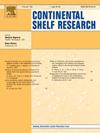Determining meteorological tidal transport through a channel on the coast
IF 2.2
3区 地球科学
Q2 OCEANOGRAPHY
引用次数: 0
Abstract
Transient weather systems are often associated with alternating warm and cold advections of air masses and changing wind directions, which drive coastal ocean and estuarine waters to oscillate quasi-periodically. Quantifying water transport under these meteorologically induced oscillations — between inland waterways and the coastal ocean — helps to interpret land-ocean interactions, sediment transport, and other effects of migrating weather systems. The challenge lies in the difficulty of obtaining continuous, long-term direct measurements of transport due to logistical constraints. Here, we apply a method to determine the meteorological tide-induced volume transport of water using an intensive survey. We correlate transport values measured by a boat-mounted ADCP with vertically averaged velocities from a bottom-mounted ADCP, which recorded a much longer time series. The correlation is then used to compute transport over the period of the bottom-mounted ADCP deployment. Observations were conducted at Belle Pass, Port Fourchon. The transport data revealed the impact of weather systems, including four cold fronts. A model of volume transport, accounting for rotary cold front wind variations, was applied, where both along-channel and along-coastline wind components contribute to the remote wind effect, leading to a more complex response to passing weather systems. The local wind effect is much smaller than the remote wind effect, and transport is primarily controlled by water level fluctuations resulting from open boundary input. Finally, the channel orientation relative to the coastline is found to be critical in determining both the magnitude and phase of the transport.
测定沿海航道的气象潮汐输送
瞬态天气系统通常与气团的冷暖交替平流和风向的变化有关,这驱动了沿海海洋和河口水域的准周期性振荡。在这些气象诱发的振荡下——在内陆水道和沿海海洋之间——量化水运有助于解释陆地-海洋相互作用、沉积物运输和迁移天气系统的其他影响。挑战在于,由于后勤方面的限制,难以获得对运输的连续、长期的直接测量。在这里,我们采用一种方法来确定气象潮汐引起的水的体积运输通过密集的调查。我们将船载ADCP测量的传输值与底部ADCP的垂直平均速度相关联,后者记录了更长的时间序列。然后使用相关性来计算底部安装的ADCP部署期间的传输。观察是在富尔雄港的贝尔山口进行的。运输数据揭示了天气系统的影响,包括四个冷锋。采用了考虑旋转冷锋风变化的体积运输模型,其中沿通道和沿海岸线的风分量都有助于远程风效应,导致对过去天气系统的更复杂响应。局地风效应远小于远地风效应,输运主要受开放边界输入引起的水位波动控制。最后,相对于海岸线的水道方向被发现是决定运输的大小和阶段的关键。
本文章由计算机程序翻译,如有差异,请以英文原文为准。
求助全文
约1分钟内获得全文
求助全文
来源期刊

Continental Shelf Research
地学-海洋学
CiteScore
4.30
自引率
4.30%
发文量
136
审稿时长
6.1 months
期刊介绍:
Continental Shelf Research publishes articles dealing with the biological, chemical, geological and physical oceanography of the shallow marine environment, from coastal and estuarine waters out to the shelf break. The continental shelf is a critical environment within the land-ocean continuum, and many processes, functions and problems in the continental shelf are driven by terrestrial inputs transported through the rivers and estuaries to the coastal and continental shelf areas. Manuscripts that deal with these topics must make a clear link to the continental shelf. Examples of research areas include:
Physical sedimentology and geomorphology
Geochemistry of the coastal ocean (inorganic and organic)
Marine environment and anthropogenic effects
Interaction of physical dynamics with natural and manmade shoreline features
Benthic, phytoplankton and zooplankton ecology
Coastal water and sediment quality, and ecosystem health
Benthic-pelagic coupling (physical and biogeochemical)
Interactions between physical dynamics (waves, currents, mixing, etc.) and biogeochemical cycles
Estuarine, coastal and shelf sea modelling and process studies.
 求助内容:
求助内容: 应助结果提醒方式:
应助结果提醒方式:


